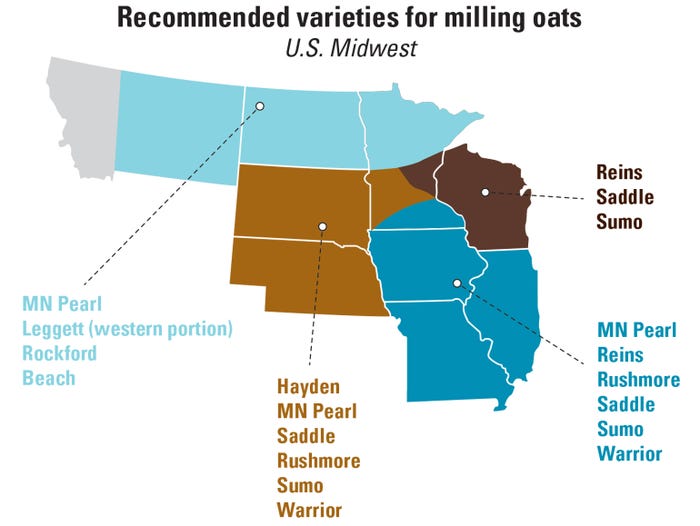
If you’ve considered adding another crop to your rotation, you might want to try oats.
Beth Stebbins, the small grains buyer with Grain Millers in Eden Prairie, Minn., offered several reasons why growing oats is a worthwhile venture in her presentation Feb. 3 during an Albert Lea Seed webinar.
Grain Millers processes about 25% of the oats in North America. It has three oat mills — in Iowa, Oregon and Saskatchewan — and two cleaning plants in Minnesota and Saskatchewan.
“There are a few reasons why it’s a great year for oats, that when put together, really make a good case for adding in the crop,” she said. First, relatively speaking, oats are low-input. Second, with the increase in input prices this year, reducing the need for these inputs is a good strategy. Third, oat prices (as of mid-February) were at historic highs. Harvest delivery was around $5.50 per bushel for oats delivered to St Ansgar, Iowa, she said. Last year at this time, oats were around $3.50 per bushel.
Plus, adding a third crop to a rotation is shown to be beneficial to soil health, and it breaks up pest- and herbicide-resistant weed challenges.
Oats are in demand, notably due to oat milk, Stebbins added. Oat milk is gaining popularity among consumers who are looking for a milk alternative, and it is a popular choice in coffee beverages. For some, oat milk appears more environmentally friendly than other milk alternatives. It’s also allergen-friendly, she noted, adding that both soy and almond are among the top eight allergens.
Oat basics
Stebbins usually sets up grower contracts in January. The contract stipulates minimum and maximum oat specifications, such as a 38-pound test weight, 14% maximum moisture, 3% maximum for material, 20% maximum thins and 1.0 ppm maximum for vomitoxin. Oats treated with glyphosate as a preharvest desiccant are not accepted.
As of mid-February, Grain Millers was not contracting — yet it may resume later, she said.
Grain Millers also offers suggestions on oat varieties best suited for the Upper Midwest, and the company helps new growers get started with oats.
“Variety selection is key,” Stebbins said.

Grain Millers recommends 10 varieties for the Upper Midwest, depending on where you farm. The varieties MN Pearl and Saddle seem to work well across most of Minnesota. Other varieties include Leggett, Rockford, Beach, Hayden, Rushmore, Sumo, Warrior and Reins.
“These are what we found worked well in general for growers in these regions last year,” Stebbins said.
To help new oat growers get going, Grain Millers partners with Practical Farmers of Iowa, which provides a cover crop cost-share program.One of Grain Millers’ customers, Oatly, helps fund the cost share to help increase domestic oat production, Stebbins added.
The Iowa program offers two cost-share options, one that involves harvesting a small grain and planting a summer cover crop, and another that involves reducing nitrogen in corn that follows small grains. To qualify, growers farm in Iowa, Illinois, Minnesota, Nebraska or Wisconsin, among other requirements.
“I hear ‘I can’t grow quality oats in the Midwest,’” Stebbins says. “Yes, you can.”
She shared a few agronomic tips: Oats do not like getting hot, so plant the crop early. Do not plant oats back to back with other cereals. You can straight-cut oats, and you do not have to swath.
Plus, the carbon opportunities are different, she said.
“Oats can be grown carbon-negatively,” she said. “That cuts red tape, so you don’t have to sell a carbon credit. A premium can be added onto the oat price.”
For more information on marketing oats, conduct Stebbins at Grain Millers, [email protected]. Learn more about the company at grainmillers.com
To learn about the cost-share program for small grains offered by Practical Farmers of Iowa, visit practicalfarmers.org/small-grains-cost-share-sign-up.
About the Author(s)
You May Also Like






